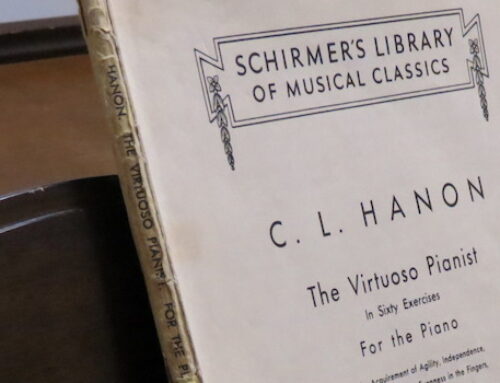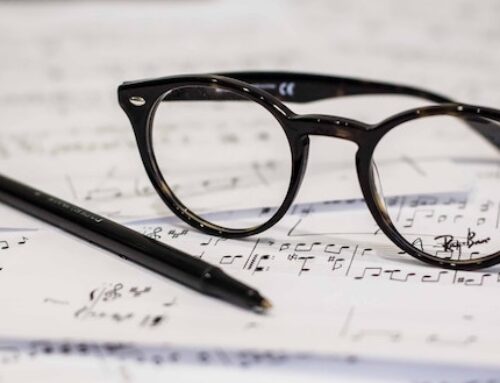Thank you so much for your patience as I finished up a busy semester! As my first post back, I thought I’d share one of the things I was up to while I was gone. Below you’ll find my music history research paper. It’s kind of long for a blog post, so I’ve included an abstract too. Enjoy!
Abstract:
Throughout his career as a piano instructor, Carl Czerny emphasized teaching improvisation, an art that may have contributed to the harmonic understanding, technical development, and musical memory of eighteenth- and nineteenth-century pianists. Improvising publicly was common practice during Czerny’s life. His treatise on improvisation identifies a solid understanding of harmony, excellent technique, and good musical memory as necessary skills for improvising. Research also suggests that improvising itself can help to improve these skills. Elaborating basic harmonic progressions allows pianists to exercise quick harmonic thinking. Similarly, improvising technical routines gives pianists continually changing passages in which to apply technical rules. Recalling learned repertoire to use for creative self-expression will train different aspects of musical memory than merely recreating a learned piece. Sadly, improvisation has largely disappeared from classical piano education because the role of performer has shifted from a creative to an interpretive one. Reintroducing the practice, however, may benefit pianists even in the art of interpreting pre-written music, and we would be amiss not to.
Full Paper:
Public improvisation significantly contributed to the fame of virtuosos such as Ludwig van Beethoven and Franz Liszt. As pupil of Beethoven and teacher of Liszt, Carl Czerny plays a key role in the history of piano pedagogy. His treatise on improvisation and secondary research by scholars including Martin Gellrich, Richard Parncutt, and Valerie Woodring Goertzen provide a basis for exploring the role of improvisation in piano education. In the early nineteenth century, learning to improvise may have served pianists in more subtle ways than just allowing them to impress audiences with spectacular spontaneous performances. Czerny’s teaching emphasized developing the skill of improvisation, which contributes to a student’s harmonic understanding, technical development, and musical memory but has largely disappeared from contemporary classical piano education.
During Czerny’s life, the culture surrounding piano performance was largely connected to improvisation. Duels between pianists thrived as artists competed to especially impress audiences with extemporaneous performance and more virtuosity. At the beginning of this treatise, Czerny outlines three elements related to improvising and composing: natural aptitude, thorough training in all branches of harmony, and virtuosity.[6] He lists several elements of “natural aptitude,” which someone can further develop, if not learn from scratch. Most notable among them is “ample musical memory.”[7] Though he acknowledges that some level of talent is required, he states in his Letters to a Young Lady, on the Art of Playing the Pianoforte, that anyone can learn to improvise.[8] First, improvisation requires developing a solid understanding of harmony since just as “all music may be reduced to simple chords,” “simple chords . . . serve as the ground-work on which to invent and play all sorts of melodies, passages, skips, embellishment, &c [sic].”[9] Flawless technique is also necessary because, in Czerny’s words, “the happiest talent avails nothing, when the fingers are incapable of following and obeying its dictates.”[10] Lastly, excellent musical memory serves improvisation by providing performers with ideas from passage work, practiced preludes, and learned repertoire. If pianists desire to improvise well, they must spend time practicing these three skills. Interestingly, however, during the eighteenth and nineteenth centuries, improvising itself may have played a role in developing and solidifying these very skills. As Czerny explains in his letters, all music can boil down to chord progressions, and so also an improvisation elaborates a chord progression. His treatise provides an example of a basic chord progression (see example 1) and different approaches to elaborating it. Example 2 features rolled chords and arpeggiation. Example 1: Czerny, A Systematic Introduction to Improvisation on the Pianoforte, p. 7. Example 2: Czerny, A Systematic Introduction to Improvisation on the Pianoforte, p. 7. In example 3, Czerny includes moving notes filled with neighbor and scalar motion, accompanied by chords in the left hand. Example 4 uses florid scales and arpeggios, ending with a rising chromatic Example 3: Czerny, A Systematic Introduction to Improvisation on the Pianoforte, p. 7. scale in thirds and a blocked dominant to tonic cadence. Because of the nature of improvisation, Example 4: Czerny, A Systematic Introduction to Improvisation on the Pianoforte, p. 7–8. it provides an opportunity to practice smooth modulations and quickly and instinctively apply learned rules about harmony.[11] It may also serve to reveal how well a student actually “knows” these rules. Improvisation naturally pushes the harmonic knowledge from the brain to the fingers, where it can actually serve its purpose. Similarly, improvisation can function as a framework in which to practice technique. Mastering finger exercises, scales, and arpeggios provides pianists with a musical language. These passages will inevitably appear in compositions and can serve as helpful filler when faced with a lack of inspiration while extemporizing. During Czerny’s lifetime, however, practicing these technical passages involved elaborating on them with the intention of practicing applying fingering rules and varying touch within “realistic musical contexts.”[12] Students and teachers invented their own exercises instead of practicing from a written score.[13] Throughout his life, Czerny’s student Franz Liszt, among other well-known pianists such as Clara Schumann, regularly improvised his own passagework.[14] This kind of practice helped pianists learn to apply fingering rules since most printed scores of the time did not include fingerings.[15] Czerny teaches a set of fingering rules in the second volume of his Opus 500 Piano Forte School. The volume provides the basic rules: that the four long fingers should never pass over one another, that the same finger must not play two or more consecutive keys, and that the thumb and little finger should never go on the black keys in playing the scales; and outlines exceptions, providing exercises for practice along the way.[16] He expects students to transpose exercises, applying the fingering rules to a new arrangement of white and black keys.[17] As noted by Valerie Woodring Goertzen, President of the Southern Chapter of the American Musicological Society, improvisation also indirectly impacted technical development in that “published preludes [originally meant to serve as models for improvisation], with their battery of scales, arpeggios, and passagework, provided a body of short, moderately demanding practice pieces for the amateur or student wishing to improve his or her technique.”[18] Published studies, focusing on overcoming a particular technical challenge, also originated in the improvisation of a pianist-composer.[19] According to Gellrich and Parncutt, “Until about 1850, free improvisation was one of the most important means by which pianists developed virtuosity.”[20] Ernst Ferand, a respected scholar on improvisation, claims that there is “scarcely a musical technique or form of composition that did not originate in improvisatory performance or was not essentially influenced by it.”[21] Improvising may also impact the brain’s ability to remember music. It is interesting to note that two excellent improvisors, Franz Liszt and Clara Schumann, were among the first to publicly perform music by memory.[22] Speculating a causal relationship would be assuming too much, but the correlation does beg the question of what impact their improvising may have had on their ability to memorize. As Gellrich and Parncutt point out, improvising helps develop aural skills.[23] These aural skills may aid in musical memory by allowing musicians to more easily recognize patterns. In addition, improvising allows pianists to exercise their memory of drilled passages and pieces. If pianists seek to retrieve the memories of learned exercises, preludes, and works by the great composers in order to use them for creative self-expression rather than merely recreate them, they may develop different aspects of their memory. After this kind of practice engaging musical memory, a pianist may better recall a prepared piece. To the harm of classical piano education, improvisation has largely disappeared from the culture of classical music. The idea that improvisation depends almost entirely on natural ability may have contributed to its decline.[24] Additionally, modern parents may not expose children to music as early or extensively as in the past, preventing them from developing familiarity with a musical language for improvisation.[25] The pursuit of virtuosity during the height of public piano improvisation may have also grown to overshadow creative ability.[26] Because the technical vocabulary expanded so much and new technology allowed for printing in large quantities, the easiest way to keep track of all the technical ideas was by publishing piano methods.[27] Instead of using them as mere guides though, pianists started practicing technical exercises from scores. Czerny probably unknowingly contributed to the decline of the art he believed important by publishing a large number of technical exercises. The most significant factor contributing to the decline of improvisation, however, was the separation between the role of composer and performer, creating a shift in piano performance from a creative art to an interpretive art. This was connected to the development of a canon of works as well as composers’ desire to exercise more control over their own compositions, possibly because more amateurs were now involved in interpreting them. Regardless, this shift led classical pianists to focus exclusively on the art of interpreting pre-written works and neglect to further explore improvisation. A full understanding of harmony, flawless technique, and a keen musical memory, however, are all skills that modern pianists pursue in order to adequately fulfill their role as interpreters. Classical pianists may find value in reintroducing improvisation into the standard piano education, even if just for the sake of practicing these skills. There is much more to explore about the broader benefits of improvising, the cognitive processes involved, and the best approaches to teaching it. Based on the benefits already explored, however, we can conclude that by ignoring the role it played in the past, we may be missing out on an excellent learning and teaching tool. Let us take Hummel’s advice to improvise freely: “Even if a person plays with inspiration, but always from a written score, he or she will be much less nourished, broadened, and educated than through the frequent offering of all of his or her powers in a free fantasy practiced in the full awareness of certain guidelines and directions, even if this improvisation is only moderately successful.”[28] 1. Alice L. Mitchell, “Translator’s Foreword” in Carl Czerny, A Systematic Introduction to Improvisation on the Pianoforte, Op. 200 (New York: Longman, 1983), p. xi.




Endnotes
2. Valerie Woodring Goertzen, “By Way of Introduction: Preluding by 18th- and Early 19th-Century Pianists,” The Journal of Musicology 14 (Summer 1996), 307–308.
3. Martin Gellrich and Richard Parncutt, “Piano Technique and Fingering in the Eighteenth and Nineteenth Centuries: Bringing a Forgotten Method Back to Life,” British Journal of Music Education 15 (March 1998), 6.
4. Charles Czerny, Letters to a Young Lady, on the Art of Playing the Pianoforte; ed. Bea Friedland, trans. J.A. Hamilton (New York: Da Capo Press, 1982), pp. 78–82.
5. Carl Czerny, “Recollections from My Life,” trans. Ernest Sanders, The Musical Quarterly 42 (July 1956), 17.
6. Czerny, A Systematic Introduction to Improvisation, p. 2.
7. Ibid.
8. Czerny, Letters to a Young Lady, p. 79.
9. Ibid., p. 80.
10. Czerny, Letters to a Young Lady, p. 81.
11. Czerny, A Systematic Introduction to Improvisation, p. 2.
12. Gellrich and Parncutt, “Piano Technique and Fingering,” 6–7.
13. Ibid., 8–9.
14. Ibid., 9.
15. Ibid., 10.
16. Charles Czerny, Piano Forte School, Op. 500 (London: Messrs. R. Cocks & Co., n.d.), vol. 2, pp. 2–3, IMSLP, 24 April 2015, http://imslp.org/wiki/Pianoforte-Schule,_Op.500_(Czerny,_Carl)
17. Gellrich and Parncutt, “Piano Technique and Fingering,” 12.
18. Woodring Goertzen, “By Way of Introduction: Preluding,” 336.
19. Gellrich and Parncutt, “Piano Technique and Fingering,” 8.
20. Ibid.
21. Ernst T. Ferand, Improvisation in Nine Centuries of Western Music: An Anthology With a Historical Introduction (Köln: A. Volk Verlag, 1961) in Robin Moore, “The Decline of Improvisation in Western Art Music: An Interpretation of Change,” International Review of the Aesthetics and Sociology of Music 23 (June 1992), 62.
22. Jennifer Mishra, “A Century of Memorization Pedagogy,” Journal of Historical Research in Music Education 32 (2010), 3.
23. Gellrich and Parncutt, “Piano Technique and Fingering,” 10.
24. Alice L. Mitchell, “Translator’s Foreword,” p. x.
25. Robin Moore, “The Decline of Improvisation,” 64.
26. Woodring Goertzen, “By Way of Introduction: Preluding,” 334.
27. Gellrich and Parncutt, “Piano Technique and Fingering,” 9.
28. Johann N. Hummel, Anweisung zum Piano-Forte-Spiel, 2d ed., 468 in Woodring Goertzen, “By Way of Introduction: Preluding,” 305.






Leave A Comment